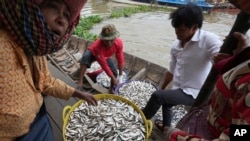Climate change and upstream dams, most of them controlled by China, are threatening Cambodia's enormous Tonle Sap Lake and its surrounding communities, putting the nation's protein supply and the greater Mekong River ecosystem at risk.
The three-year stretch from 2019-2021 was the driest on record. The Tonle Sap's vital flood pulse appeared to be dying, along with much of the lake's bountiful fish stocks. Water typically flows into the Tonle Sap Lake for 120 days during the wet season, swelling it as much as six-fold before running back into the Mekong River as the rainy season ends, usually in late September. This fluctuation is the pulse.
And while the past two years have seen more rainfall, a nearly normal wet-season lake expansion and the usual reversed flow, such temporary relief cannot offset the long-term effects of a lake in crisis, experts and officials told VOA Khmer.
"The new normal is uncertainty," said Brian Eyler, who directs the Stimson Center's programs on Southeast Asia and energy, water and sustainability. "That the predictability of a traditional expansion happening nearly every wet season, or every monsoon season, cannot be relied upon." The Stimson Center is in Washington.
Fears of the ecosystem dying out have drawn international attention, given the Tonle Sap's distinction as one of the world's most productive inland fisheries — and as the source of most of the protein consumed by Cambodians.
Over the past two years, Tonle Sap Lake has reached nearly normal total flow, according to the Stimson Center's Mekong Dam Monitor project. However, in 2022 much of that flow came later in the wet season due to heavy rainfall, meaning the lake missed out on the early-season inflows that carry sediment, larva and nutrients crucial to annual fish stocks.
Last year saw monthly flows nearly track historical averages, which produced a decent fishing season, according to the Stimson project. Data from Cambodia's Fisheries Administration show 413,200 metric tons of freshwater fish were caught in 2019, then 383,050 in 2021 and just 368,059 in 2022. A Fisheries spokesperson told VOA Khmer that 426,750 metric tons of freshwater fish were caught in 2023. Each metric ton equals 1,000 kg.
"For now, the ecosystem of the Mekong seems to be … not like it was before, but it's still there. It hasn't completely died out," Eyler said in January during an interview on the Zoom platform.
The Mekong Dam Monitor is seeking to track where flow originates, where it is being stopped upstream, and how the decisions made by each of the countries are affecting the other nearby nations.
According to its data, the total flow into the Tonle Sap would have been 12.4% higher in September, when it reached its 2023 peak, if it weren't for water being withheld upstream, mostly in Chinese reservoirs.
China in the past two years appears to have withheld less water, compared with previous years, according to the monitoring project. Yet it's unclear if that's because it is responding to the concerns from downstream communities or because its needs were less, according to the Stimson project.
One phenomenon the Stimson researchers are watching closely is how the wet season is changing. It is arriving later and lasting longer than historical norms, a possible reflection of climate change.
"If indeed that's true, and [if] we can substantiate it, then there's reason for the dams upstream not to hold water back at the beginning of the wet season, and to hold water back at the end of the wet season," said Alan Basist, president of Eyes on Earth and a co-lead researcher of the Mekong Dam Monitor, during the January interview.
The Chinese Embassy in Washington said the "rational development" of the Mekong, which China calls the Lancang River, is in the overall interest of all countries that depend on it.
"China always attaches great importance to the concerns and needs of the countries downstream, maintains close communication with them, commits itself to carrying out cooperation on water resources with relevant countries such as sharing hydrological data and flood control and drought relief," said embassy spokesperson Liu Pengyu in an email on February 26.
The Mekong River Commission (MRC) is the main regional body tasked with bringing countries together to coordinate water management and consult on potential new dam projects on the massive river and its tributaries.
In 2020, the MRC attributed the delayed swelling to lower 2019 rainfall and operations of upstream Mekong hydropower dams, two of which are in Laos and 11 in China.
But the MRC Secretariat said in an email to VOA Khmer in February that it was too soon to know what the "new normal" looks like, given recent droughts and "human activities in the basin," or how these changes would ultimately affect surrounding communities.
Mak Bunthoeurn, a program manager at the NGO Forum on Cambodia who works with communities along the Mekong and its tributaries in Cambodia, said they have found little cause for optimism, even with the recent relative increase in total flow.
Advocacy groups working with these communities want more data, particularly from China, Mak Bunthoeurn added during a Zoom interview in late January. "I suggest that the governments of the Mekong River have to work together, to cooperate, to ensure that downstream communities will not suffer."
